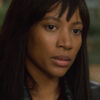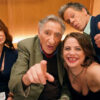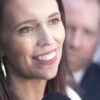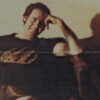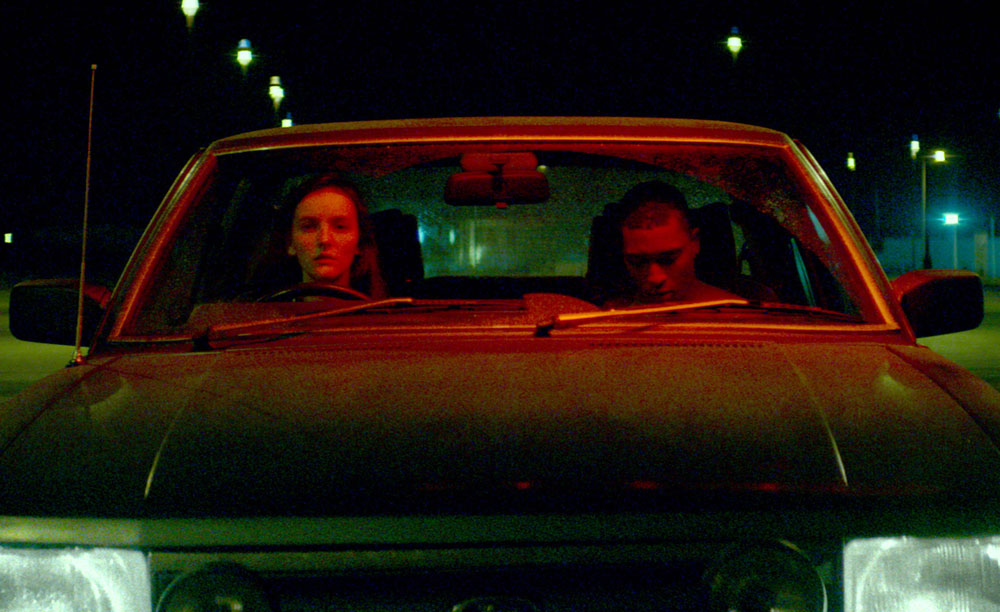In the small town of Co Louth on the border of Northern Ireland, where “Kissing Candice” is set, crime isn’t uncommon since it’s something to do in a place where there are few other forms of entertainment. While this isn’t something to be celebrated, it is something filmmaker Aoife McArdle found had an unexpected upside.
“Because there’s quite a lot of crime in the area, they keep their lights on at night,” says McArdle, who knew of Co Lough because it’s where her parents met not long before moving to the only slightly larger burgh of Omagh. “It’s kind of a dream for a filmmaker because you can take these incredible photographs with all these beautiful shadows and lights and colors in them, so I always find it to be a really visually inspiring area.”
As brilliant as the street lamps and porchlights are, set against skies that can ripple with pinks and purples before turning to deep blue, it is McArdle who shines brightest in “Kissing Candice,” a stunning feature debut that tells of a 17-year-old (Ann Skelly) who’ll drift off into fantasies as an escape from the drudgery of small-town life, living under the thumb of her father (John Lynch), who laments, “Things were a lot safer here during the Troubles.” The worlds collide when she comes across Jake (Ryan Lincoln), a young man with gang ties that she believes she’s first become acquainted with in her dreams, and while she wants to make a break from the town to escape boredom, he’d like to put his criminal past behind him, giving the two an instant bond even if they barely know each other. While McArdle had never gone on the lam herself, it was a feeling she could relate to as an article.
“I was always into photography and writing and then I was at a school where I wasn’t encouraged to be a director,” says McArdle, who since went on to make music videos for the likes of U2 (“Every Breaking Wave”) and Bryan Ferry (“Loop De Li”). “It’s quite tricky when you’re from a small town in the middle of nowhere. That’s not seen as a real opportunity, but it was always something I wanted to do and eventually found my way into that path.”
Putting the fire into blazing a trail with her feature directorial debut, McArdle bathes the couple in florid reds and greens that teem with passion and will often lead viewers quietly into environments with a slow creep of the camera to ultimately overwhelm them with the whims of nature, both environmental and human, in ways that are unpredictable and electric. As the thriller opens across Europe and is being made available on demand in the States, McArdle spoke about the inspiration behind the film, how she worked with her young lead actors and getting back into the feverish mindset of a teenager.

I guess since I’d been a kid, I’ve always wanted to make features – I’m one of people who at six or seven years old, I wanted to be a director. I was always glued to the TV. I was never one of those kids that was playing outside. [laughs] And I have a really vivid memory of watching old film noir and [films] like “Taxi Driver” and “Paris, Texas,” thinking when I was very small, “I want to do that.” So on that level, you could say every time I make a shortform piece of work, whether it be a music video or a commercial, I was always trying to make a narrative of some kind.
But when the opportunity came up to apply for this funding from the Irish Film Board and I was approached about doing it, I applied and it all happened quite fast, so even though it was something in the back of my mind that I always wanted to do, I didn’t actively seek it out and once the opportunity came and they picked the script, I was like, “Oh my God, okay, I have to do this now” and really went for it. My parents are both from the area that we filmed in on the border of Ireland and it’s such an interesting, visually rich area. I spent all my summers in that area, so I had a lot of locations in my head that I always wanted to feature in a film. It’s got this ‘50s faded glamour about it in a way and it just made sense to write about that area.
The colors are so striking – did you have those tones in your head from the start?
I had a color palette in my mind for the film and I’m a huge fan of rich, vivid colors, but I wanted the vivid colors to very much come from the natural world, so every color in there is grounded in that earthiness. It was like blood reds and dark, rich tree greens and midnight blues and mustards. Obviously, the shadows and all of the colors in there are the very visceral kind, and there’s a thematic meaning to all the colors of course as well – the reds are very much about danger, but also the passion and the danger mixed together and I liked the idea of those blood reds repeating and the midnight blues disappearing into those at points.
It’s part of sucking you into this world, which you also do through the scene construction – often, action will burst out of a scene rather than drive it initially. How did that style come about?
I’m a huge fan of the audience being swept up in the story via the camera and we all find out at the same time what’s happening. I really like the idea of the cinematography being experiential like that, so it’s quite instinctual. When I’m storyboarding, that’s just the way I see a scene and I like the camerawork having that fluidity and that rhythmic choreography all the time. Both visually and sonically, I want to pull the audience in to the story and make them really experience it rather than sit back and observe it, so that style is a way of doing that.
[In general], I like the idea of it being very fluid, the idea that the audience was very much with Candice, and the way her brain was fluidly moving between [her dreams and reality]. We also had to experience it that way, rather than to be spoonfed it, so there’s really this question of is this real or is this not real in the way she’s doing. And sometimes dreams were incredibly vivid and colorful, but sometimes the reality was even weirder than the dream. That was something that was very teenage as well [because] there’s a lot of experimentation as a teenager, psychologically – you’re testing the world, you’re seeing things in so many different ways. It’s a hugely powerful time to be alive. So I felt like the film should really reflect that – the way a teenage mind is fluid and chaotic and experimental – and I love the idea that not only do you move between dream and reality, but you move between genres – romance, coming of age, thriller, horror – the way as a teenager your interests move that way.How’d you find your leads?
With a lot of searching. I met hundreds of young people in Ireland. We did extensive street casting and looked in a lot of brilliant theater schools, and and I purely went on instinct, really. We did intense auditions and I just started to gravitate toward both of them. [Ann and Ryan] had an element within them that really suited the character – but not everything [which] I liked because I wanted them to bring their own thing. We did really intense rehearsals together [where] they could bring their own individual spark. For instance, Ryan had this incredible nervous energy – he [has this] bubbling [quality that’s] infectious and Ann has this gorgeous voice and this enigmatic quality and that were a lovely integral part of the characters, but also something unique that they brought. Then we kept on building and building on those in the rehearsals until they were the characters. They invested every inch of their bodies in those parts and I think it shows because we worked so hard together on making it the way we wanted it to be.
Our window of shooting was very short, so we were hammering it and doing one or two takes on every scene, and that rehearsal time together was invaluable because we never would’ve made our shooting days if we hadn’t had that brilliant time to really hone the film and get the performances as strong as they are.
It seems like it might’ve been nice to have a veteran presence like John Lynch as well.
Yeah, for sure. A lot of experience and he was a gentleman – a lovely man to work with and so passionate about the script, which was lovely. It was great for all of us. We all had a chance to experience his wisdom, but what was lovely about him was just how immersed he was in the process. This is a low budget film – it was like an incredibly intense summer camp. We were all piled into this B & B together, lo-fi, no luxury whatsoever, very intense long hours, and he came with no expectations or airs. He’s hugely humble and gifted man and I think all the young actors felt really in awe of him and learned a lot from him, which was lovely.
Did the weather cooperate? You get such amazing skies in this.
No. Of course not. [laughs] God, the only thing you can predict about Irish weather is that you can’t predict it. One moment it’s the most incredible sky, two minutes later it’s raining, a minute later it might be hail stones, then you’ll get a bit of sun again, so I spent a lot of time standing in the rain being soaked waiting for a window of light. But I must say there’s something so electric about the skies in Ireland after you get rain and sun together – I was looking for that really heavy sky and I couldn’t always achieve what I wanted in camera, so there is a huge amount of post in it, but I like the post to be invisible so hopefully the audience doesn’t feel it.
I’m a huge fan of grading and I love to paint every frame as if it is a painting, so I spent months in the [color] grade with George Kay, a lovely man that I work with in London, and we literally painted the film shot by shot to give it that dystopian look I wanted.
You couldn’t tell. It also looked like the big action sequences were all practical.
I really enjoy the really technical set-pieces and choreographing the camera for those, but they were very ambitious and we did them all in one day, which was pretty insane. We did all our stunt tracking and technocrane shots in one night – the car crash and the [climactic] chase, so we really were on the edge of our seat shooting those and everything was smashed up and upside down for real. That was an amazingly intense experience, but fantastic.
On a first feature, was this what you thought it would be?
It was a lot harder. It’s exhausting and all consuming – and I think that has largely to do with the low budget, but I was slightly shellshocked by those things, but then also it was so rewarding how much fun I had with the actors and how much fun I had just building a world. You don’t really have time to do on a small film, so it was beautiful to have that opportunity.
“Kissing Candice” is now available to rent on Amazon and Vimeo on Demand.
